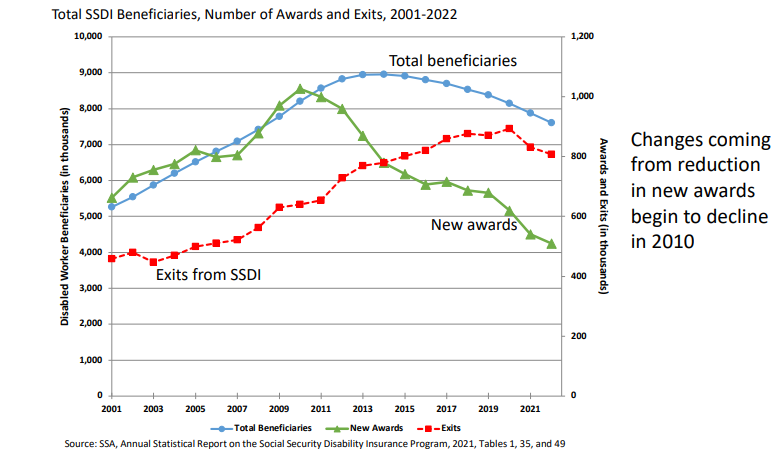The Surprising Epilogue to an Infamous Conn Job
June 10, 2025
In government scandals, some surnames are especially memorable, even decades later. A fugitive financier named Marc Rich (and his partner Pinky Green) were famously pardoned by Bill Clinton in what “reeked of payoff” for contributions to the Clinton Library. Then there’s former Rep. Pat Swindall (R-GA), who was indicted for perjury. The puns write themselves.
But nothing compares to the epic saga of Eric Conn, the aptly-named lawyer who perpetrated what the Department of Justice called “the largest fraud scheme in the history of the Social Security program.” A 2024 NBER study provides a surprising epilogue. With little notice, the Social Security Administration (SSA) closed loopholes Conn exploited, which contributed to steadily declining disability rolls, contrary to expert projections.
A 2017 article summarizes Conn’s case:
Mr. Conn, working with a then-administrative law judge and a psychologist, secured hundreds of millions of dollars in disability payments for claimants through fraudulent means….from October 2004 to April 2016, he worked with others to submit thousands of fake medical documents to the Social Security Administration, resulting in more than $550 million in lifetime benefits to claimants. He earned more than $5.7 million in fees as part of it, according to the plea.
Conn touted himself as “Mr. Social Security” on billboards around impoverished eastern Kentucky. Outside his law practice, he installed a 19-foot tall statue of Abraham Lincoln alongside a replica of the Statue of Liberty. According to the Washington Post, “Conn once hired a Miss Kentucky USA to be his public relations director” and “had a crew of ‘Conn Hotties’ — women in tight T-shirts printed with the firm’s 1-800 number, whom he sent to public events.” After pleading guilty in early 2017, Conn cut off his electronic monitoring device and fled the country. Following six months on the lam, a SWAT team arrested him in Honduras. His case was featured on 60 Minutes and an Apple TV documentary called “The Big Conn.” He is currently in federal prison with a scheduled release date of 2039.
The Social Security Disability Insurance (SSDI) eligibility process is complicated, but Conn’s scheme was simple. Pay off doctors and judges to ensure his clients’ benefit applications were approved, earning him significant fees from the government. As Sen. Tom Coburn (R-OK) summarized, Conn and his corrupt colleagues “moved hundreds of claimants onto the disability rolls based on manufactured medical evidence and boilerplate decisions.”
The scheme started to unravel after a 2011 Wall Street Journal expose on disability judge David Daugherty, who was in Conn’s pay and had “trouble saying ‘no’” to benefit applications. Judicial determinations are also the focus of a 2024 study, which finds SSA reforms have quietly closed the loopholes Conn exploited. Those reforms include “generational turnover in the judicial corps” starting in 2008 and “training initiatives to improve policy compliance” among all judges starting in 2010. SSA also conducted “focused reviews of judges who were outliers” like Daugherty.
The study authors call the changes “possibly the most important (and least heralded) SSDI reforms of our time.” They find the reforms “led to significant declines in the allowance rate, explaining 28-36 percent of the 22 percentage point decline in allowance rates between 2007 and 2015.” Fewer allowances eventually led to fewer total beneficiaries:

That picture of declining caseloads contrasts sharply with prior forecasts. The 2010 Social Security Trustees’ report notes there were 7.788 million disabled worker beneficiaries in 2009 just as the reforms began. Under its intermediate (or “best guess”) assumptions, the SSDI caseload was projected to grow to 9.290 million in 2015 and 9.669 million in 2020. Instead, the caseload peaked at 8.955 million in 2014 and has fallen every year since. The caseload fell to 8.151 million in 2020 (15.7 percent below the 2010 projection) and to 7.366 million in 2023—17.7 percent off the 2014 peak and considerably below even the low-cost estimates in the 2010 report.
These changes had nothing to do with DOGE or legislative mandates, and a strengthening economy and increased work from home among other factors may have contributed to declining rolls. But the reforms reflect the Social Security Administration’s recognizing a major problem—which was flagrantly exploited by Eric Conn and his co-conspirators to inflate caseloads—and instituting appropriate repairs that resulted in less dependence. Such reform is a mundane but important part of effective governance—and taxpayers could use more of it.
Sign up for AEI on Poverty
A newsletter highlighting work on poverty–and efforts to reduce it–from AEI’s Poverty Studies team



